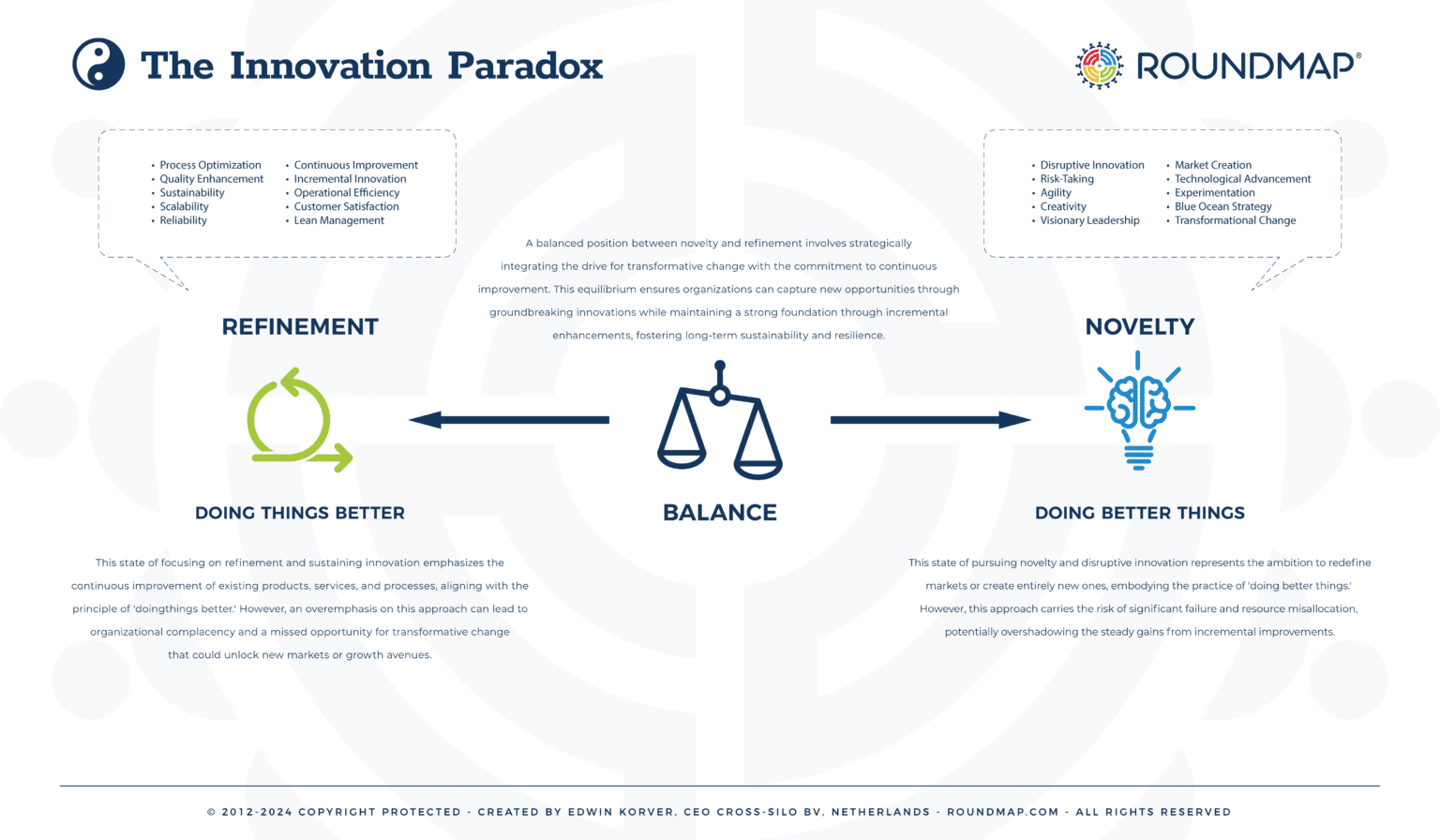In an era where transformative change is often heralded as the ultimate goal for forward-thinking leaders, one must pause and ask: At what cost does this relentless pursuit come, and what might we be overlooking in the race towards the next big leap?
In the ever-evolving business world, innovation transcends its role from a mere strategy to an indispensable catalyst for companies aiming to thrive amidst the complexities of growth and transformation. Central to this odyssey is a paradox that challenges the strategic acumen of leaders: the intricate balance between the methodical enhancement of existing capabilities and the pursuit of groundbreaking innovations.
This paradox underscores a critical strategic choice: the path of “sustaining innovation,” which is about methodically refining and enhancing value, optimizing performance in a slow-and-steady manner, versus the path of disruptive innovation, which compels organizations to venture boldly into uncharted territories, embracing transformative changes that have the potential to redefine entire market landscapes.
The Path of Steady Refinement
Refinement is the art of incremental improvement, also called sustaining innovation. Sustaining innovation, seen through the lens of systems thinking as ‘doing things better,’ focuses on evolving existing products, services, or processes to efficiently meet the ever-changing needs of consumers and the market. It’s a commitment to continuous enhancement, ensuring reliability and delivering consistent value to stakeholders while maintaining a competitive edge.
However, an exclusive focus on refinement risks stagnation, potentially leaving companies vulnerable to disruptive forces or missing out on new market opportunities.
The Pursuit of Acute Novelty
On the opposite end of the spectrum is novelty — the pursuit of groundbreaking innovations that redefine the market. This approach is characterized by its high-risk, high-reward nature, often aiming to disrupt the status quo, hence the term ‘disruptive innovation,’ with transformative products, services, or business models. Novelty seeks to leapfrog over competitors by shifting market dynamics, often creating new markets or reshaping existing ones.
Yet, pursuing novelty without a grounding in refinement can lead to instability, as not all innovations reach their transformative potential, and resources may be spread too thin.
Navigating the Paradox
Innovation is vital for organizational growth and evolution, presenting leaders with a pivotal paradox: how to balance the pursuit of continuous improvement with the quest for transformative change. A strategic, dual approach, leveraging refinement and novelty, emerges as the path forward.
• Embracing a Dual Mindset
Organizations thrive by cultivating a culture that equally values incremental improvements and groundbreaking innovations. This balanced perspective fosters resilience and adaptability, enabling companies to meet current demands while pursuing long-term, visionary objectives.
• Strategic Resource Allocation
Investing in refining existing offerings and exploring innovations ensures a stable foundation from which to pursue potentially disruptive ventures. This approach allows for a dynamic resource allocation, supporting immediate needs and future growth.
• Fostering a Culture of Learning
A commitment to continuous learning through experimentation and embracing calculated risks drives sustainable innovation. Encouraging teams to learn from successes and failures supports a culture where refinement and novelty are pursued with vigor.
• Aligning with Core Values and Mission
Ensuring that innovation efforts—whether aimed at refinement or novelty—align with an organization’s core values and overarching mission guarantees that these efforts contribute to sustainable success.
• Encouraging Risk-taking
Addressing hesitancy around risk is crucial for fostering novelty-driven innovation. Highlighting the importance of a supportive environment that encourages risk-taking and values learning from failure can inspire more entrepreneurs to explore new territories.
• Supporting a Conducive Ecosystem
Government, investors, and the business community are critical to creating an ecosystem supporting innovation. Access to funding, mentorship, and a favorable regulatory framework are essential components of this supportive environment.
• Bridging Idea and Execution
Recognizing the challenges in transforming innovative ideas into successful products or services underscores the importance of strategic foresight, operational capabilities, and perseverance in the innovation process.
• Valuing Incremental Innovation
Acknowledging the role of incremental innovations alongside disruptive ones highlights the importance of a balanced approach to innovation, where both refinement and novelty are valued for their contributions to progress.
• Cultivating Continuous Learning and Adaptability
Promoting a culture that embraces new ideas, technologies, and methodologies ensures that organizations remain adaptable and innovation-focused, prepared to thrive in an ever-changing landscape.
• Understanding the Entrepreneurial Impact
Recognizing the diverse impact of entrepreneurial firms on the economy—from the marginal to the transformative—provides a deeper understanding of innovation’s nuanced landscape.
• Differentiating Entrepreneurial Firms
Adopting a continuum perspective to differentiate between types of entrepreneurial firms, from undersized, marginal enterprises to high-performance “gazelles,” allows for a more realistic evaluation of entrepreneurship’s impact.
• Addressing Methodological Challenges
Acknowledging the methodological challenges in analyzing entrepreneurial activity and its impact on innovation and economic growth calls for nuanced metrics and approaches that align with a balanced innovation strategy.
• Policy Implications and Realistic Evaluations
Advocating for policies that recognize the diversity within the entrepreneurial ecosystem and provide targeted support based on the distinct needs and potential impacts of firms across the continuum can foster a more effective innovation framework.
• Avoiding Composition Fallacies
Emphasizing the importance of avoiding composition fallacies in innovation discussions ensures a strategic, nuanced approach that recognizes the diverse contributions of different types of firms to the innovation ecosystem.
Conclusion
The essence of navigating this paradox lies in choosing between sustaining and disruptive innovation and masterfully blending these approaches to foster long-term resilience, adaptability, and sustainable innovation. It is a test of leadership to harmonize ‘doing things better’ with ‘doing better things,’ ensuring that the pursuit of novelty does not overshadow the importance of refinement and that the quest for improvement does not inhibit the potential for transformative change.
Author
-
Edwin Korver is a polymath celebrated for his mastery of systems thinking and integral philosophy, particularly in intricate business transformations. His company, CROSS/SILO, embodies his unwavering belief in the interdependence of stakeholders and the pivotal role of value creation in fostering growth, complemented by the power of storytelling to convey that value. Edwin pioneered the RoundMap®, an all-encompassing business framework. He envisions a future where business harmonizes profit with compassion, common sense, and EQuitability, a vision he explores further in his forthcoming book, "Leading from the Whole."
View all posts Creator of RoundMap® | CEO, CROSS-SILO.COM






